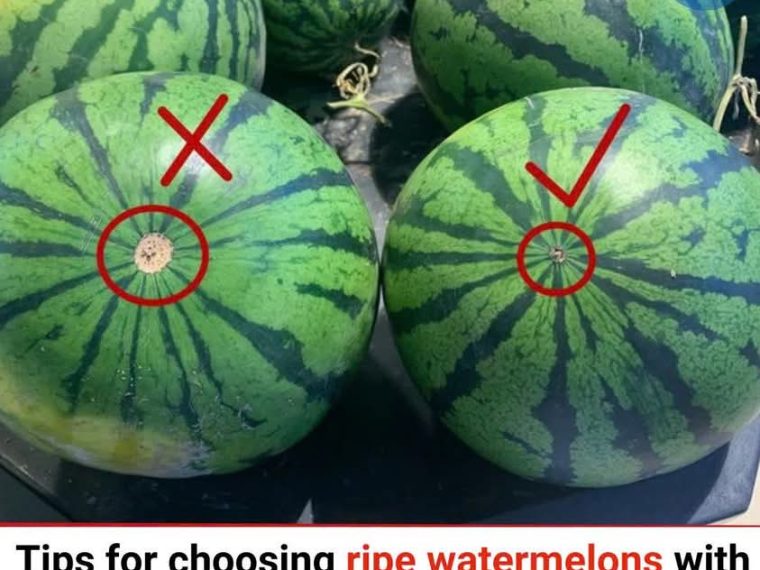Tips for Choosing a Ripe Watermelon with Red Flesh, Sweet Flavor, and Paper-Thin Rind
Watermelon is a summer favorite, offering a refreshing, hydrating, and sweet treat perfect for hot days. However, selecting the right watermelon can be tricky because not all watermelons are equally ripe or flavorful. When you’re in the store or at a farmer’s market, you want to pick a watermelon with deep red flesh, a sweet taste, and a thin rind for the best eating experience. Here’s a complete guide to help you select the best watermelon every time.
1. Understand the Different Varieties
Watermelons come in different varieties, and while they all share the same basic characteristics, each type has unique traits. Most of the sweet, red-fleshed watermelons with thin rinds are of the seedless variety, but there are other varieties to consider:
- Seedless Watermelon: Known for its sweet, red flesh and thin rind, seedless watermelons are easier to eat and are often more sought after.
- Picnic Watermelon: These are larger, round watermelons often seen in grocery stores. They have a thicker rind but offer a lot of flesh.
- Personal Watermelon: Smaller, round watermelons that have a thinner rind and sweeter, red flesh with fewer seeds.
When looking for the perfect watermelon, you might want to choose a seedless variety for the best eating experience.
2. Look for a Symmetrical Shape
The first thing to consider when choosing a watermelon is its shape. A good watermelon should be symmetrical and well-formed. Irregularities or dents may indicate poor growth conditions or under-ripeness. Opt for a watermelon that is round or oval, with no noticeable deformities, cracks, or bruises.
3. Check the Watermelon’s Skin
The skin of the watermelon is your first indicator of ripeness. It should have a smooth, shiny surface and a deep green color. The presence of a field spot—a rough patch where the melon rested on the ground during growth—is also an important indicator. A yellow field spot suggests that the watermelon ripened properly in the field. Avoid watermelons with white or pale field spots, as they often indicate that the melon was picked too early.
Additionally, check for any cuts, soft spots, or blemishes, as these can lead to spoilage.
4. Examine the Sugar Content
When choosing a watermelon, you want it to be sweet, and sweetness is determined by the sugar content. A ripe watermelon will have a higher sugar content, which results in a rich, sweet flavor. While there’s no surefire way to measure sugar content just by looking, the “sugar belt” technique may help. Tap the melon gently to see if it produces a deep sound or a “hollow” resonance. This sound indicates that the fruit has a good sugar balance and is likely sweet.
5. Tap for a Hollow Sound
Tapping or knocking on the watermelon is an age-old trick to determine ripeness. Ripe watermelons produce a deep, hollow sound when tapped, which signifies that the melon is full of water and sugar. If the sound is dull or flat, the watermelon might not be as ripe, or it may be overripe with more water content and less sugar.
6. Choose a Watermelon with the Right Weight
When selecting a watermelon, weight matters. A ripe watermelon should feel heavy for its size. This heaviness indicates that the melon has retained a lot of water content, which is a good sign of freshness. Watermelons with low water content might feel lighter and tend to be less flavorful.
7. Look for Red Flesh
The flesh of the watermelon should be a vibrant deep red or pink color. This is the mark of a sweet, ripe watermelon. A bright red flesh is often a sign that the watermelon has been allowed to ripen on the vine for optimal sweetness. Avoid watermelons with pale, off-white, or yellowish flesh, as this often means the melon is under-ripe or overripe.
8. Thin Rind
One of the signs of a great watermelon is a thin rind relative to the amount of flesh inside. A thin rind means there’s more of the sweet, red flesh to enjoy. While some watermelons can have a thicker rind, particularly larger varieties, seek out melons with a thinner rind, as they usually indicate better taste and a higher flesh-to-rind ratio.
9. Check the Sugar Smell
Watermelons have a mild but distinct smell. A ripe, sweet watermelon often has a fragrant, sugary aroma near the stem. If you can smell the sweetness from the stem end of the watermelon, this is a good indicator that it’s ripe and sweet. On the other hand, a watermelon that smells neutral or not very fragrant may be under-ripe.
10. Check for the Presence of Seeds
If you’ve chosen a seedless watermelon, it should have minimal or no seeds at all. However, some seedless varieties may have tiny, soft seeds, which are perfectly edible and not a cause for concern. If you are purchasing a seeded watermelon, ensure that the seeds are mature and black, which indicates the melon is fully ripened.
11. Consider Seasonality
Watermelon is a warm-season fruit, and its peak season typically runs from late spring to early fall, depending on your location. Buying watermelon in-season ensures that you are getting a melon that has been allowed to ripen fully on the vine. Out-of-season watermelons may be transported from warmer regions and might not be as sweet or flavorful.
12. Store Watermelon Properly
Once you’ve selected a perfect watermelon, proper storage is crucial to maintaining its freshness and taste. If you plan to eat the watermelon right away, you can store it at room temperature. However, if you need to store it for later, place it in the fridge. To preserve the melon’s flavor, avoid cutting it until you’re ready to eat it. Once cut, store the pieces in an airtight container in the fridge for up to 5 days.
Conclusion
Choosing the perfect watermelon is a combination of understanding the variety, paying attention to the exterior, and knowing what to look for in terms of texture, weight, and sound. By following these tips, you’ll be well on your way to picking the sweetest, juiciest watermelon with red, flavorful flesh and a thin rind, perfect for a summer treat. Happy melon hunting!





